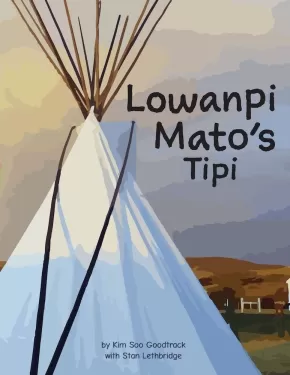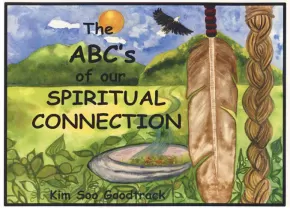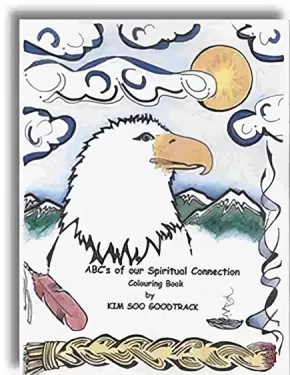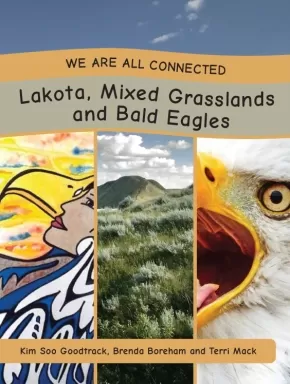
Kim Soo Goodtrack
Kim is a retired schoolteacher, artist, author, and TV series creator. Kim is Hunkpapa Lakota. Her home reserve is the Wood Mountain Reserve in Saskatchewan. Kim’s great-grandma walked up to Canada with Sitting Bull’s people in 1877. Kim’s Lakota name is Wichapi Wi (Star Woman). It was given to her by Joe Flyingby at Issac Dog Eagle’s Sundance on Little Eagle Reserve in South Dakota. Kim lives and works in her studio in Rockglen, Saskatchewan, painting, sewing, making jewelry, and creating whatever comes to mind!
Books (1)
Strong Science - Animals Teacher's Guide
 $30.00
$30.00

Artists:
Format:
Coil Bound
Text Content Territories:
Indigenous Canadian; First Nations; Sioux; Lakota; Hunkpapa;
Grade Levels: 1;
ISBN / Barcode: 9781771746274
Synopsis:
Synopsis:
This teacher’s guide supports a language-based Science unit for early primary classrooms, using the sixteen titles in Strong Nations Publishing’s Strong Science - Animals series.
The unit introduces early primary students to four easily recognizable animals that live in or near many communities in Canada: beaver, black-tailed deer, mallard duck, and raccoon. While learning about the animals, students will gain knowledge and skills mandated by Ministry of Education Science curricula in Canadian provinces and territories.
In addition, this teacher’s guide addresses other curriculum areas— Language Arts, Math, Social Studies, and Art—and provides information to help develop an appreciation for and understanding of Indigenous cultures.
This teacher-friendly, comprehensive teacher’s guide provides:
• lesson plans to introduce the books in the Strong Science - Animals series;
• lesson plans to address knowledge and skills common to Canadian Science curricula;
• activities to integrate the unit across the curriculum;
• activities to wrap up the unit;
• reproducible activity pages.
Educator Information
The Strong Science - Animals series and teacher's guide is recommended for use with grade one students, but it may also be useful in kindergarten classes.
Additional Information
170 Pages | 8.5" x 11" | Coil Bound
Kids Books (14)
1234 First Nations Explore
$19.99
Artists:
Format:
Paperback
Text Content Territories:
Indigenous Canadian; First Nations;
ISBN / Barcode: 9780978182328
Synopsis:
Synopsis:
This book provides a wonderful way to learn about First Nations cultures while counting! The traditional teachings are interesting and informative. Counting concepts, from numbers 1 to 21, promote harmony and goodwill.
Educator Information
The 1234 book gives children a chance to count while learning about Indigenous Peoples from across Turtle Island.
Additional Information
45 Pages | 11” x 8.5”
1234 First Nations Explore Activity Book
$10.99
Format:
Paperback
Text Content Territories:
Indigenous Canadian; First Nations;
ISBN / Barcode: 9780978182342
Synopsis:
Synopsis:
There are 21 activities for children to complete in this activity book. From 3 tipis to 12 Eagle feathers in a feather fan, children will draw, cut, paste, and create!
Educator Information
This activity book pairs with the 1234 First Nations Explore book.
Additional Information
23 Pages | 8.5” x 11”
Lowanpi Mato’s Tipi
 $18.50
$18.50

Artists:
Format:
Hardcover
Text Content Territories:
Indigenous Canadian; First Nations; Sioux; Lakota;
ISBN / Barcode: 9781771744751
Synopsis:
Synopsis:
“Hokahe! Welcome!”
Welcome to Wood Mountain, home of the Lakota People, in southern Saskatchewan. It is here that we meet Stan Lethbridge, whose ancestral name is Lowanpi Mato (Singing Bear).
Join Lowanpi Mato as he prepares to set up his summer Tipi. He shares with us Lakota life values and traditions, and how they connect to building and taking care of a Tipi. He teaches us that to build a Tipi you need many items; some are from natural sources and others are purchased from a store. Lowanpi Mato takes us through a step-by-step building process so that we can all learn how a Tipi is built.
The Lakota language is woven throughout the story. The Lakota counting chart on pages 30 and 31 invites you to learn to count and have some fun looking back through the book to find items that match each number.
Welcome to Wood Mountain, home of the Lakota People, in southern Saskatchewan. It is here that we meet Stan Lethbridge, whose ancestral name is Lowanpi Mato (Singing Bear).
Join Lowanpi Mato as he prepares to set up his summer Tipi. He shares with us Lakota life values and traditions, and how they connect to building and taking care of a Tipi. He teaches us that to build a Tipi you need many items; some are from natural sources and others are purchased from a store. Lowanpi Mato takes us through a step-by-step building process so that we can all learn how a Tipi is built.
The Lakota language is woven throughout the story. The Lakota counting chart on pages 30 and 31 invites you to learn to count and have some fun looking back through the book to find items that match each number.
Educator Information
Lakota language is woven throughout this story, as are the seven values of Lakota life.
Lakota language is woven throughout this story, as are the seven values of Lakota life.
Includes a counting chart from 1 to 20 in Lakota, as well as a search-and-find counting game.
Additional Information
32 pages | 8.5" x 11" | Hardcover | ISBN: 9781771744751
32 pages | 8.5" x 11" | Hardcover | ISBN: 9781771744751
Strong Science - Animals: A Home for the Beavers
 $7.50
$7.50

Artists:
Format:
Paperback
Text Content Territories:
Indigenous Canadian;
Grade Levels: Kindergarten; 1;
ISBN / Barcode: 9781771746120
Synopsis:
Synopsis:
This story is about a beaver home.
Beavers make homes out of sticks, rocks, and mud.
There are four seasons in the year: winter, spring, summer, and fall. Which season is this story about?
Educator & Series Information
Recommended for grade 1 students, but may also be useful in kindergarten classrooms.
Strong Science - Animals is a language-based science series for primary students featuring animals that all Canadian students will recognize. Photographs and Indigenous artwork illustrate the series. Common learning objectives in science curricula across Canada are addressed, and suggestions for extending the learning to other curriculum areas, including Indigenous cultural awareness, language arts, math, and art, are included in the teacher’s guide. The sixteen books in this series are grouped into four levels that increase in complexity, designed to accommodate students with various reading abilities within a classroom. This feature facilitates the use of this series in literacy programs along with the Strong Readers series.
A Home for the Beavers is an EP3 (Early Primary 3) book in the Strong Science - Animals series. Font size decreases as language complexity and word count increase across levels: EP1 books have approximately 40 words, EP2 books have approximately 60 words, EP3 books have approximately 80 words, and EP4 books have approximately 100 words.
A teacher's guide for Strong Science - Animals is available: Strong Science - Animals: Teacher's Guide
Authenticity Note: This book has received the Indigenous Text label because the author is Indigenous (Lakota) and the featured animal holds cultural significance in many Indigenous cultures. The engaging story provides factual information in an easy-to-read format for children to learn science concepts and build literacy skills. It promotes respect for animals and Mother Earth, and its illustrations communicate additional cultural information through Lakota symbolism and designs. Further cultural connections are identified in the teacher's guide. Refer to the guide to explore the book's Indigenous connections fully. It is up to readers to determine if the book will work as a stand-alone authentic Indigenous text for their purposes.
Additional Information
16 Pages | 6.5" x 5.5" | Paperback | ISBN: 9781771746120
Strong Science - Animals: Baby Beaver
 $7.50
$7.50

Artists:
Format:
Paperback
Text Content Territories:
Indigenous Canadian;
Grade Levels: Kindergarten; 1;
ISBN / Barcode: 9781771746045
Synopsis:
Synopsis:
This book is about a baby beaver.
Beavers cut down trees.
Why do you think beavers cut down trees?
Educator & Series Information
Recommended for grade 1 students, but may also be useful in kindergarten classrooms.
Strong Science - Animals is a language-based science series for primary students featuring animals that all Canadian students will recognize. Photographs and Indigenous artwork illustrate the series. Common learning objectives in science curricula across Canada are addressed, and suggestions for extending the learning to other curriculum areas, including Indigenous cultural awareness, language arts, math, and art, are included in the teacher’s guide. The sixteen books in this series are grouped into four levels that increase in complexity, designed to accommodate students with various reading abilities within a classroom. This feature facilitates the use of this series in literacy programs along with the Strong Readers series.
Baby Beaver is an EP1 (Early Primary 1) book in the Strong Science - Animals series. Font size decreases as language complexity and word count increase across levels: EP1 books have approximately 40 words, EP2 books have approximately 60 words, EP3 books have approximately 80 words, and EP4 books have approximately 100 words.
A teacher's guide for Strong Science - Animals is available: Strong Science - Animals: Teacher's Guide
Authenticity Note: This book has received the Indigenous Text label because the author is Indigenous (Lakota) and the featured animal holds cultural significance in many Indigenous cultures. The engaging story provides factual information in an easy-to-read format for children to learn science concepts and build literacy skills. It promotes respect for animals and Mother Earth, and its illustrations communicate additional cultural information through Lakota symbolism and designs. Further cultural connections are identified in the teacher's guide. Refer to the guide to explore the book's Indigenous connections fully. It is up to readers to determine if the book will work as a stand-alone authentic Indigenous text for their purposes.
Additional Information
16 Pages | 6.5" x 5.5" | Paperback | ISBN: 9781771746045
Strong Science - Animals: Baby Deer
 $7.50
$7.50

Artists:
Format:
Paperback
Text Content Territories:
Indigenous Canadian;
Grade Levels: Kindergarten; 1;
ISBN / Barcode: 9781771746083
Synopsis:
Synopsis:
This book is about a baby deer.
Baby deer can swim and jump.
Have you seen a baby deer? Where was it?
Educator & Series Information
Recommended for grade 1 students, but may also be useful in kindergarten classrooms.
Strong Science - Animals is a language-based science series for primary students featuring animals that all Canadian students will recognize. Photographs and Indigenous artwork illustrate the series. Common learning objectives in science curricula across Canada are addressed, and suggestions for extending the learning to other curriculum areas, including Indigenous cultural awareness, language arts, math, and art, are included in the teacher’s guide. The sixteen books in this series are grouped into four levels that increase in complexity, designed to accommodate students with various reading abilities within a classroom. This feature facilitates the use of this series in literacy programs along with the Strong Readers series.
Baby Duck is an EP1 (Early Primary 1) book in the Strong Science - Animals series. Font size decreases as language complexity and word count increase across levels: EP1 books have approximately 40 words, EP2 books have approximately 60 words, EP3 books have approximately 80 words, and EP4 books have approximately 100 words.
A teacher's guide for Strong Science - Animals is available: Strong Science - Animals: Teacher's Guide
Authenticity Note: This book has received the Indigenous Text label because the author is Indigenous (Lakota) and the featured animal holds cultural significance in many Indigenous cultures. The engaging story provides factual information in an easy-to-read format for children to learn science concepts and build literacy skills. It promotes respect for animals and Mother Earth, and its illustrations communicate additional cultural information through Lakota symbolism and designs. Further cultural connections are identified in the teacher's guide. Refer to the guide to explore the book's Indigenous connections fully. It is up to readers to determine if the book will work as a stand-alone authentic Indigenous text for their purposes.
Additional Information
16 Pages | 6.5" x 5.5" | Paperback | ISBN: 9781771746083
Strong Science - Animals: Baby Duck
 $7.50
$7.50

Artists:
Format:
Paperback
Text Content Territories:
Indigenous Canadian;
Grade Levels: Kindergarten; 1;
ISBN / Barcode: 9781771746090
Synopsis:
Synopsis:
This book is about a baby duck.
Baby ducks come out of eggs.
Have you seen a baby duck? Where was it?
Educator & Series Information
Recommended for grade 1 students, but may also be useful in kindergarten classrooms.
Strong Science - Animals is a language-based science series for primary students featuring animals that all Canadian students will recognize. Photographs and Indigenous artwork illustrate the series. Common learning objectives in science curricula across Canada are addressed, and suggestions for extending the learning to other curriculum areas, including Indigenous cultural awareness, language arts, math, and art, are included in the teacher’s guide. The sixteen books in this series are grouped into four levels that increase in complexity, designed to accommodate students with various reading abilities within a classroom. This feature facilitates the use of this series in literacy programs along with the Strong Readers series.
Baby Duck is an EP1 (Early Primary 1) book in the Strong Science - Animals series. Font size decreases as language complexity and word count increase across levels: EP1 books have approximately 40 words, EP2 books have approximately 60 words, EP3 books have approximately 80 words, and EP4 books have approximately 100 words.
A teacher's guide for Strong Science - Animals is available: Strong Science - Animals: Teacher's Guide
Authenticity Note: This book has received the Indigenous Text label because the author is Indigenous (Lakota) and the featured animal holds cultural significance in many Indigenous cultures. The engaging story provides factual information in an easy-to-read format for children to learn science concepts and build literacy skills. It promotes respect for animals and Mother Earth, and its illustrations communicate additional cultural information through Lakota symbolism and designs. Further cultural connections are identified in the teacher's guide. Refer to the guide to explore the book's Indigenous connections fully. It is up to readers to determine if the book will work as a stand-alone authentic Indigenous text for their purposes.
Additional Information
16 Pages | 6.5" x 5.5" | Paperback | ISBN: 9781771746090
Strong Science - Animals: Baby Raccoon
 $7.50
$7.50

Artists:
Format:
Paperback
Text Content Territories:
Indigenous Canadian;
Grade Levels: Kindergarten; 1;
ISBN / Barcode: 9781771746052
Synopsis:
Synopsis:
This book is about a baby raccoon.
Raccoons can climb trees.
Why do you think raccoons climb trees?
Educator & Series Information
Recommended for grade 1 students, but may also be useful in kindergarten classrooms.
Strong Science - Animals is a language-based science series for primary students featuring animals that all Canadian students will recognize. Photographs and Indigenous artwork illustrate the series. Common learning objectives in science curricula across Canada are addressed, and suggestions for extending the learning to other curriculum areas, including Indigenous cultural awareness, language arts, math, and art, are included in the teacher’s guide. The sixteen books in this series are grouped into four levels that increase in complexity, designed to accommodate students with various reading abilities within a classroom. This feature facilitates the use of this series in literacy programs along with the Strong Readers series.
Baby Raccoon is an EP1 (Early Primary 1) book in the Strong Science - Animals series. Font size decreases as language complexity and word count increase across levels: EP1 books have approximately 40 words, EP2 books have approximately 60 words, EP3 books have approximately 80 words, and EP4 books have approximately 100 words.
A teacher's guide for Strong Science - Animals is available: Strong Science - Animals: Teacher's Guide
Authenticity Note: This book has received the Indigenous Text label because the author is Indigenous (Lakota) and the featured animal holds cultural significance in many Indigenous cultures. The engaging story provides factual information in an easy-to-read format for children to learn science concepts and build literacy skills. It promotes respect for animals and Mother Earth, and its illustrations communicate additional cultural information through Lakota symbolism and designs. Further cultural connections are identified in the teacher's guide. Refer to the guide to explore the book's Indigenous connections fully. It is up to readers to determine if the book will work as a stand-alone authentic Indigenous text for their purposes.
Additional Information
16 Pages | 6.5" x 5.5" | Paperback | ISBN: 9781771746052
Strong Science - Animals: Deer in the Snow
 $7.50
$7.50

Artists:
Format:
Paperback
Text Content Territories:
Indigenous Canadian;
Grade Levels: Kindergarten; 1;
ISBN / Barcode: 9781771746168
Synopsis:
Synopsis:
This story is about how deer find food when it snows.
There are four seasons in the year: winter, spring, summer, and fall. Which season is this story about?
Educator & Series Information
Recommended for grade 1 students, but may also be useful in kindergarten classrooms.
Strong Science - Animals is a language-based science series for primary students featuring animals that all Canadian students will recognize. Photographs and Indigenous artwork illustrate the series. Common learning objectives in science curricula across Canada are addressed, and suggestions for extending the learning to other curriculum areas, including Indigenous cultural awareness, language arts, math, and art, are included in the teacher’s guide. The sixteen books in this series are grouped into four levels that increase in complexity, designed to accommodate students with various reading abilities within a classroom. This feature facilitates the use of this series in literacy programs along with the Strong Readers series.
Deer in the Snow is an EP3 (Early Primary 3) book in the Strong Science - Animals series. Font size decreases as language complexity and word count increase across levels: EP1 books have approximately 40 words, EP2 books have approximately 60 words, EP3 books have approximately 80 words, and EP4 books have approximately 100 words.
A teacher's guide for Strong Science - Animals is available: Strong Science - Animals: Teacher's Guide
Authenticity Note: This book has received the Indigenous Text label because the author is Indigenous (Lakota) and the featured animal holds cultural significance in many Indigenous cultures. The engaging story provides factual information in an easy-to-read format for children to learn science concepts and build literacy skills. It promotes respect for animals and Mother Earth, and its illustrations communicate additional cultural information through Lakota symbolism and designs. Further cultural connections are identified in the teacher's guide. Refer to the guide to explore the book's Indigenous connections fully. It is up to readers to determine if the book will work as a stand-alone authentic Indigenous text for their purposes.
Additional Information
16 Pages | 6.5" x 5.5" | Paperback | ISBN: 9781771746168
Strong Science - Animals: Mother and Baby Raccoons
 $7.50
$7.50

Artists:
Format:
Paperback
Text Content Territories:
Indigenous Canadian;
Grade Levels: Kindergarten; 1;
ISBN / Barcode: 9781771746137
Synopsis:
Synopsis:
This story is about the home mother raccoon makes in a tree for her babies. The home is called a den.
There are four seasons in the year: winter, spring, summer, and fall. Which season is this story about?
Educator & Series Information
Recommended for grade 1 students, but may also be useful in kindergarten classrooms.
Strong Science - Animals is a language-based science series for primary students featuring animals that all Canadian students will recognize. Photographs and Indigenous artwork illustrate the series. Common learning objectives in science curricula across Canada are addressed, and suggestions for extending the learning to other curriculum areas, including Indigenous cultural awareness, language arts, math, and art, are included in the teacher’s guide. The sixteen books in this series are grouped into four levels that increase in complexity, designed to accommodate students with various reading abilities within a classroom. This feature facilitates the use of this series in literacy programs along with the Strong Readers series.
Mother and Baby Raccoons is an EP3 (Early Primary 3) book in the Strong Science - Animals series. Font size decreases as language complexity and word count increase across levels: EP1 books have approximately 40 words, EP2 books have approximately 60 words, EP3 books have approximately 80 words, and EP4 books have approximately 100 words.
A teacher's guide for Strong Science - Animals is available: Strong Science - Animals: Teacher's Guide
Authenticity Note: This book has received the Indigenous Text label because the author is Indigenous (Lakota) and the featured animal holds cultural significance in many Indigenous cultures. The engaging story provides factual information in an easy-to-read format for children to learn science concepts and build literacy skills. It promotes respect for animals and Mother Earth, and its illustrations communicate additional cultural information through Lakota symbolism and designs. Further cultural connections are identified in the teacher's guide. Refer to the guide to explore the book's Indigenous connections fully. It is up to readers to determine if the book will work as a stand-alone authentic Indigenous text for their purposes.
Additional Information
16 Pages | 6.5" x 5.5" | Paperback | ISBN: 9781771746137
Strong Science - Animals: The Ducks Fly Away
 $7.50
$7.50

Artists:
Format:
Paperback
Text Content Territories:
Indigenous Canadian;
Grade Levels: Kindergarten; 1;
ISBN / Barcode: 9781771746175
Synopsis:
Synopsis:
This story begins with the ducks seeing the leaves on the trees turning red and yellow. How do you think this story ends?
There are four seasons in the year: winter, spring, summer, and fall. Which season is this story about?
Educator & Series Information
Recommended for grade 1 students, but may also be useful in kindergarten classrooms.
Strong Science - Animals is a language-based science series for primary students featuring animals that all Canadian students will recognize. Photographs and Indigenous artwork illustrate the series. Common learning objectives in science curricula across Canada are addressed, and suggestions for extending the learning to other curriculum areas, including Indigenous cultural awareness, language arts, math, and art, are included in the teacher’s guide. The sixteen books in this series are grouped into four levels that increase in complexity, designed to accommodate students with various reading abilities within a classroom. This feature facilitates the use of this series in literacy programs along with the Strong Readers series.
The Ducks Fly Away is an EP3 (Early Primary 3) book in the Strong Science - Animals series. Font size decreases as language complexity and word count increase across levels: EP1 books have approximately 40 words, EP2 books have approximately 60 words, EP3 books have approximately 80 words, and EP4 books have approximately 100 words.
A teacher's guide for Strong Science - Animals is available: Strong Science - Animals: Teacher's Guide
Authenticity Note: This book has received the Indigenous Text label because the author is Indigenous (Lakota) and the featured animal holds cultural significance in many Indigenous cultures. The engaging story provides factual information in an easy-to-read format for children to learn science concepts and build literacy skills. It promotes respect for animals and Mother Earth, and its illustrations communicate additional cultural information through Lakota symbolism and designs. Further cultural connections are identified in the teacher's guide. Refer to the guide to explore the book's Indigenous connections fully. It is up to readers to determine if the book will work as a stand-alone authentic Indigenous text for their purposes.
Additional Information
16 Pages | 6.5" x 5.5" | Paperback | ISBN: 9781771746175
The ABC's of our Spiritual Connection
$19.99
Artists:
Format:
Paperback
Text Content Territories:
Indigenous Canadian;
ISBN / Barcode: 9780978182304
Synopsis:
Synopsis:
The ABC’s of Our Spiritual Connection threads many First Nations Spiritual beliefs across North America.
Author/illustrator Kim Soo Goodtrack shares that our Cultural collective is rich with beauty, wisdom, and Spirit. We have so much to be proud of! Traditional teachings that have stood the test of time…even when many of the teachings were outlawed, they have survived!
Awards
- The first edition of The ABC’s of Our Spiritual Connection won a Children's Choice Award.
Educator Information
Sesame Street aired the ABC’s book for a few years. WAKANHEJA the Aboriginal Puppet show was based on the ABC book as well.
Many schools, reserves, community libraries, Head Start programs, and teacher’s colleges across North America have the ABC’s of Our Spiritual Connection in their library collections.
Additional Information
54 Pages | 11” x 8.5”
The ABC's of our Spiritual Connection Colouring Book
$9.99
Format:
Paperback
Text Content Territories:
Indigenous Canadian;
ISBN / Barcode: 9780978182311
Synopsis:
Synopsis:
This black-lined colouring book has the same text as The ABC's of our Spiritual Connection book, but totally different pictures for the children to colour. A sense of empowerment is found in many of the illustrations, be it from the ‘go girl’ playing the guitar and singing, or the young boy hoop dancing.
Educator Information
Beautiful pictures to colour with the text from the book, ABC's of our Spiritual Connection, below each one to read.
Author/Illustrator Kim Soo Goodtrack reminds educators and parents to try to encourage children to blend their colours and create shapes within a space.
Additional Information
26 Pages | 8.5” x 11”
We Are All Connected: Lakota, Mixed Grasslands and Bald Eagles
 $21.95
$21.95

Format:
Paperback
Text Content Territories:
Indigenous Canadian; First Nations; Sioux; Lakota;
ISBN / Barcode: 9781771742474
Synopsis:
Synopsis:
“We Are All Connected” is a series that explores how we all live together in a shared balance upon Mother Earth. Each book explores a specific ecosystem with a focus on one animal and its adaptations for survival within that ecosystem. Indigenous interviewees, each living within the same area, have responded to strategic questions as to how their community interacts with the land, their traditional territory. Explore each text with a sense of inquiry in mind.
8 We Are All Connected Titles Coast Salish, Coastal Rainforests and Cougars Haisla, Rivers and Chinook Salmon Inuit, Tundra and Ravens Lakota, Mixed Grasslands and Bald Eagles Métis, Wetlands and Mallards Nisga'a, Ponds and Leopard Frogs Nlaka'pamux, Grasslands and Rattlesnakes Sto:lo, Riparian Forests and Black Bears Each title covers the following curricular areas. Traditional storytelling and artwork begin each title from the focus Indigenous territory. Science: Biodiversity, classification, life cycles, food chains, food webs and connections between living and non-living things are just some of the science concepts included in each book. Social Studies: Contemporary and historical Indigenous cultural knowledge flows throughout each book. Local land forms, gatherings, harvesting practices and government are some of the social studies concepts included in each book.
2 Foundation Titles The two foundational books provide deeper understanding of the content of the “We Are All Connected” titles. We Are All Connected: The Earth, Our Home- explores biomes, ecosystems and biodiversity. We Are All Connected: The Earth, We Share- explores the interconnectedness between living and non-living things.
Authenticity Note: This work contains some Indigenous artwork and photographs throughout, such as artwork from Kim Soo Goodtrack.
Additional Information
32 pages | 8.50" x 11.00" | ISBN" 9781771742474






















